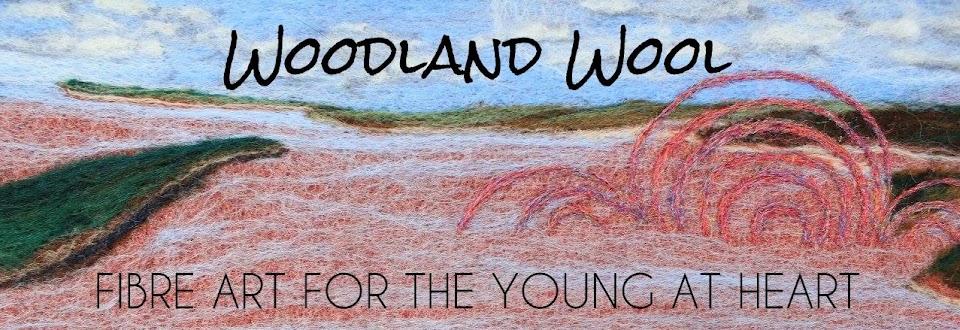Over the last year I realized that I'd been inadvertently working on a series of maps of the Avon River, the Minas Basin and the Bay of Fundy, some of which became the series Within Every Fibre (2016), What We Leave Behind (2017) and Options (2018).
 |
| Option C and Option D, on display at the Bread Gallery as a part of Culture Days, September 2018 |
With these felted maps I was exploring the scars left on the landscape by the hands of man; a record of the environment adapting in response to manipulations made by man (the causeway, dykes, gypsum mines, roads and rails).
Currently in the Avon region there has been much discussion regarding the twining of Highway 101 along the Windsor Causeway and how to resolve some of the environmental issues that were created by the initial construction 50 years ago. The lack of proper fish passage has greatly restricted migration for spawning endangered wild Atlantic Salmon and the constricted tidal flow has led to a massive build-up of silt throughout the entire Avon River, extending as far as Hantsport, leading to much erosion along the shoreline of the Avon and the other rivers that feed into it, like the St Croix and Kennetcook.
As a result the mudflats, which historically would only be visible at low tide, continue to increase in mass regularly with each flood tide. When keeping a keen eye on the daily movements of the river, subtle changes can go unnoticed. After a three month lapse away from view, the build-up is unmistakable.
After a number of years of watching the girth of the mudflats increase from season to season, I gradually came to appreciate that I was witnessing the rebirth of a saltmarsh within the river. Its ever increasing presence wasn't necessarily something to fear, but rather something to embrace, accepting the role it plays in supporting a diverse variety of life, and that it may serve an important roll in protecting our little corner of the planet as we enter this era of climate crisis.
Prior to 1604 salt marshes were extensive throughout the upper Bay of Fundy, 80% of these were lost as a result of dyking by the Acadians. When the Windsor Causeway was constructed it disrupted the natural tidal prism and within a number of years a saltwater marsh was well on its way to establishing itself. It has been reported that the marshland is growing at a rate of 2ha a year. To date there seems to be very little discussion relating to the rapidly increasing and productive saltwater marsh that is gradually expanding to fill the river, exacerbating erosion and impacting many residents and landowners along the shoreline of the river as it feeds into the Minas Basin.
Prior to 1604 salt marshes were extensive throughout the upper Bay of Fundy, 80% of these were lost as a result of dyking by the Acadians. When the Windsor Causeway was constructed it disrupted the natural tidal prism and within a number of years a saltwater marsh was well on its way to establishing itself. It has been reported that the marshland is growing at a rate of 2ha a year. To date there seems to be very little discussion relating to the rapidly increasing and productive saltwater marsh that is gradually expanding to fill the river, exacerbating erosion and impacting many residents and landowners along the shoreline of the river as it feeds into the Minas Basin.
With my position at the museum being seasonal, throughout the colder months I rarely get to experience daily life on the Avon River as I visit the community less frequently. Each spring when I return to work I find that I’m taken aback by how, within a few short months, the surrounding landscape has been so drastically altered. Mudflats continue to rise while the shoreline collapses. Hints of green spartina make themselves known, off in the distance, providing the first hint of what to expect next.
Over the past year I have created a series of maps depicting the ecological changes that have taken place in the area surrounding the site of the causeway over the last few centuries due to the hands of man. Inspired by historical references and existing maps and photographs I have rendered in fibre what the upper bay of Fundy and Avon region looked like when first colonized, how it has continued to morph drastically throughout the last century, and what to expect in the near future as tides continue to rise and saltwater marshes reestablish along the Avon.
 |
| 1960s |
 |
| 1970s |
 |
| 1990s |
 |
| 2000s |
During Culture Days I will be exhibiting my entire collection of maps created over the last several years in a pop-up showcase entitled ADAPT, on display at Artists Landing Gallery, located in the upper level of the Avon River Heritage Museum, 17 Belmont Road, Newport Landing/Avondale.








